
SIP Setup for PC Users

SIP Setup for PC Users
Complete the tech setup steps listed below on the machine you will be using for work. Please note that we cannot support Windows 7 or 8, the use of tablets, mobile devices, or netbooks (e.g.: Chromebook) for our call center applications, and we do not allow employees to use multiple machines.
You’ll need a USB headset with a wire that plugs into your machine. Additionally, you will need your mobile device for our multi-factor authentication, so please have both your work machine and mobile device when working through these steps.
Note: This page is for PC users only. If you are a MAC user, please click here.
For IT Support during business hours, click the chat icon on the right side of the page.
IT chat hours: Mon-Thurs 6 AM – 6 PM Pacific, Fri 6 AM -5 PM Pacific, Sat 6 AM -3 PM Pacific, Sun 8 AM – 3:30 PM Pacific
Expected setup time needed: Approximately 30 minutes
Step 1: Chrome Check
Ensure Chrome is Installed
You will need to use Google Chrome as your browser for your work with us. If you don’t already have Google Chrome, click here to download it.
If you are using Chrome to view this page continue to the next step. If you are using a non-chrome browser, install Chrome and reopen this page in Chrome once installation is complete.
Adjust Chrome Settings
1. Click the stack of 3 dots on the upper-right of your screen:

2. Select “Settings” from the menu that appears. This will open a new browser tab.
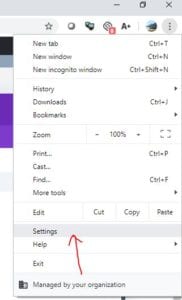
3. On the right menu bar of the new page, click into “Autofill”:
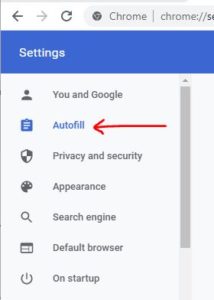
4. Click “Payment methods”:

5. Make sure that both “Save and fill payment methods” and “Allow sites to check if you have payment methods saved” are toggled off, as shown in the image below.
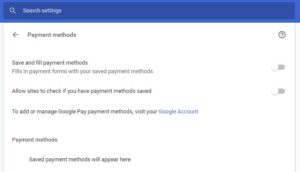
6. On the left-side “Settings” menu, click “Privacy and security”:
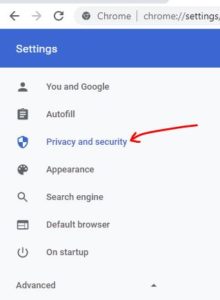
7. Click into “Site Settings”:
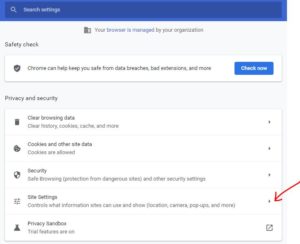
8. Scroll down and click into the “Pop-ups and redirects” row, under “Content”:
9. Make sure “Sites can send pop-ups and use redirects” is marked, and click “Add” to the right of the “Allowed to send pop-ups and use redirects” text:
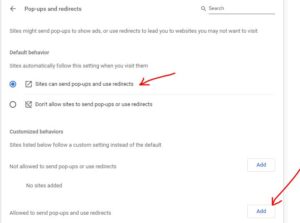
10. Paste the following URL into the site field: https://genazweb01.readingprograms.org/client/#/. Then click the blue “Add” button to finalize your entry:
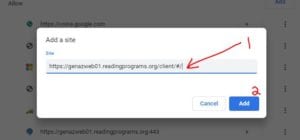
Close the window and move on to Step 2: Windows and VPN Check.
Step 2: Windows Check
Windows Updates
1. Click this link to check for Windows 10 updates.
2. When on the “Update Windows” page, make sure the tab is set to “Windows 10” (unless your machine runs Windows 11), and click the large blue “Check for Windows updates” button:

3. When presented with the “Open Settings?” question, click “Open Settings”:
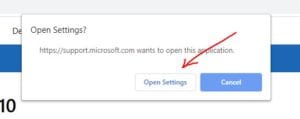
4. In the settings window, click “Install now.” If you don’t have any updates to install, move on to Step 3: Install SonicWall VPN.
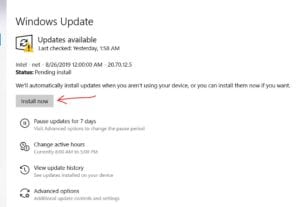
You’ll see the status of the update move through 0% to 100%, and then you’ll see the “You’re up-to-date” message display:
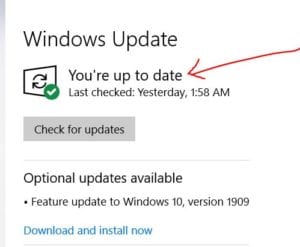
After all updates have been installed and you are up to date, proceed to Step 3.
Step 3: Install Microsoft Authenticator
This part is a one-time setup on your mobile device. Estimated time needed: 5 minutes
1. On your mobile device, download the Microsoft Authenticator app by clicking the appropriate link for your device below. If you already have Microsoft Authenticator on your device, skip to “Step 3: Download and Install SonicWall NetExtender VPN”.
Apple App link: https://apps.apple.com/us/app/microsoft-authenticator/id983156458
Android App link: https://play.google.com/store/apps/details?id=com.azure.authenticator&hl=en_US&gl=US
2. Once installed on your mobile device, open the app. Once you’ve passed the terms and conditions, pause and move on to Step 3: Download and Install SonicWall NetExtender VPN.
Step 4: Download and Install SonicWall NetExtender VPN
Returning Employees: If you have Cisco AnyConnect VPN OR SonicWall NetExtender on your machine, please uninstall the old app(s) and reboot prior to downloading the new VPN. The download below is a new version of the SonicWall NetExtender client.
1. Install the SonicWall NetExtender VPN Client by clicking the link below.
https://software.sonicwall.com/NetExtender/NetExtender-x64-10.3.1.msi
After clicking the download link, an executable file will appear at the bottom-left of your browser screen. If Chrome shows its generic download warning, click “Keep”.
Example of Chrome Warning:
What the executable file looks like (this appears after you click “Keep”, if you received the warning, OR it appears after you click the download link.):

TIP: If you are running the latest version of Chrome, downloads can be found in the top right of your browser window under the down arrow icon, as shown in the snip above.
2. Click the file to install SonicWall NetExtender VPN.
If you receive the “Windows protected your PC” screen, click “More info” within the box to continue your download, and then click “Run anyway”.
NOTE: You will be prompted to restart your machine during this install. Please be sure to complete that restart.
3. In the Setup Wizard pop-up window that appears, click “Next”.
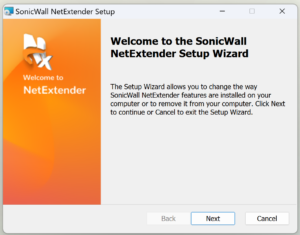
4. On the next screen, click the checkbox to the left of “I accept the terms…”, then click “Next”.
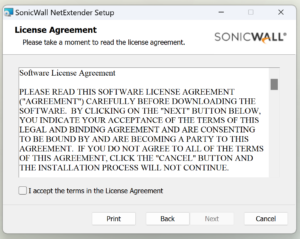
5. On the next screen, click “Next”.
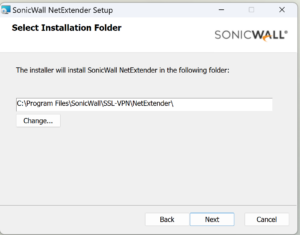
6. On the next screen, click the “Install” button with the shield image. This button is between “Back” and “Cancel”.
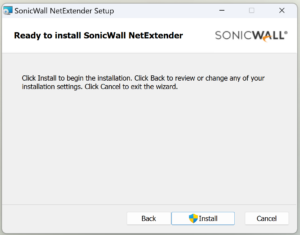
7. The install takes a few seconds. Once the screen changes to the one shown below, click “Finish”.
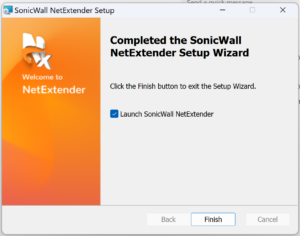
8. After you click “Finish” the box will change to a dark view with the connection setting prompts, as shown below. Click into the “Add Connection” dropdown, then click “Add Connection +”:
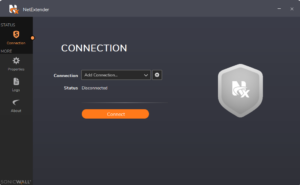 THEN:
THEN: 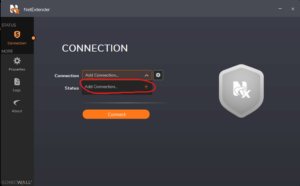
9. In the fields that appear, enter the following:
Name: IRD
Server: vpn.readingprograms.org
Username: This can be found in your tech setup email.
Password: This can be found in your tech setup email.
Domain: irdev.local (select this from the dropdown)
Protocol: Auto (should be automatically displayed in the dropdown).
Click the orange “Save” button when done.

10. Click the orange “Connect” button.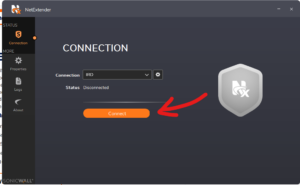
11. If you are a new employee, OR if you are a returning employee who deleted their Microsoft Authenticator VPN connection, you will see a screen that contains a QR code for you to scan with your mobile device.
It looks like this:
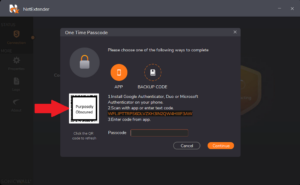
Using your mobile device, open the Microsoft Authenticator you installed earlier.
Click the white + icon on the upper right of the screen.
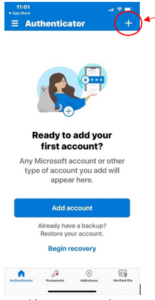
Click “Work or school account”
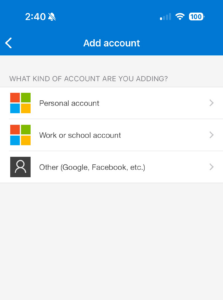
Click “Scan QR code” from the pop-up that appears
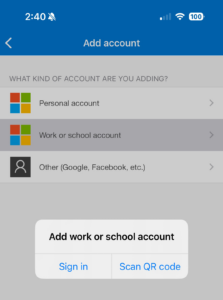
After you click “Scan QR code”, your screen will look similar to this:
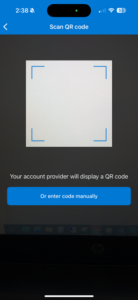
Now scan the QR code on your SonicWall NetExtender screen. Doing this will connect the two apps so they can work together.
After you scan the QR code, the Authenticator app on your mobile device will display a code.
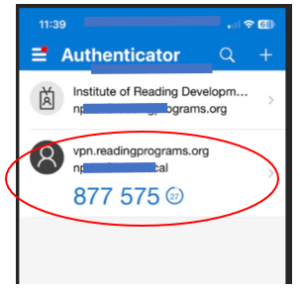
NOTE: The code will be available for 30 seconds and then a new code will appear (this cycle repeats itself). Take as much time as you need, just be sure to enter the code that exists on your screen when you go to enter the digits. Do not try to use a code that is no longer displayed on your Authenticator screen.
13. Enter the passcode you see on your Microsoft Authenticator screen into the “Passcode” field on your SonicWall NetExtender screen. Click the orange “Connect” button.
Your VPN should now be connected. Your screen will look like this: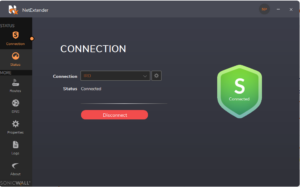
14. To make your VPN easy to find next time you log in, pin it to your task bar so it’s visible there moving forward. To do this, right-click the NetExtender icon on your task bar and click “Pin to Taskbar”.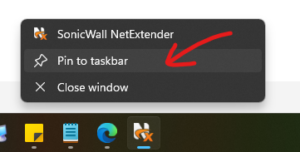
______________________________________________________________________________
Returning Employees
If you are a returning employee who did not delete their Microsoft Authenticator VPN connection, you may not see a QR code.
Instead, click the orange “App” circle, then get your mobile device out, open your Microsoft Authenticator app, and type the passcode you see for vpn.readingprograms.org into the “Passcode” field.
Click the orange “Continue” button.

Your VPN should now be connected. Your screen will look like this:
Problem-Solving Guidance
1. Check that you have the server set to “vpn.readingprograms.org” and the domain set to “irdev.local”.
2. Check that your username exactly matches what we sent to you in your tech setup email. It’s best to copy-paste directly from the email.
3. Try entering your password again. For accuracy, copy-paste directly from the email.
4. If the above guidance doesn’t help, try typing “IRDEV\” in front of your username (e.g.: IRDEV\jsmith). Enter your password as usual.
5. If you’re still encountering trouble, please chat with an IT technician, using the chat pop-out on the right of this web page.
Step 5: Install SIP Softphone
Install your SIP Softphone by clicking the link below. Please note that your SIP login credentials are in the email you received containing the link to this page. YOU MUST HAVE YOUR VPN CONNECTED BEFORE YOU ATTEMPT THIS STEP.
TIP: To watch a video on installing SIP on PC, click here.
Installation Steps
1. Click the appropriate link above: an executable file will appear at the bottom-left of your browser screen.

If you are running the latest version of Chrome, downloads can be found in the top right of your browser window under the down arrow icon.

2. Double-click the file to start your download.
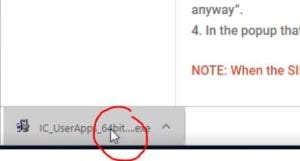
IMPORTANT: If your download has disappeared on you, or if you try to run the installer and it stops working without showing an alert, you likely need a simple “.NET” fix. Click here for the 3 simple steps you must follow to correct this issue: https://instituteofreadingdevelopmentsalesjobs.com/net_fix/
3. If presented with a message asking if you want to allow the app to make changes to your device, click “Yes.”:
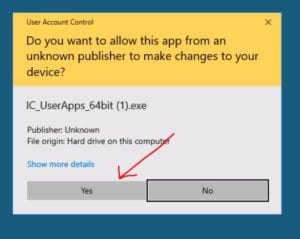
Note: If you receive the “Windows protected your PC” screen, click “More info” within the box to continue your download, and then click “Run anyway”.
4. You’ll see an install pop-up appear that tells you IC UserApps is being installed. This may take several minutes.
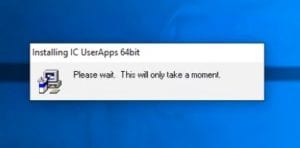
NOTE: When the SIP install has completed, the installation message box will disappear. When this happens, you are ready to move on to Step 6: Provision your SIP Softphone.
Step 6: Provision your SIP Softphone
YOU MUST HAVE VPN CONNECTED BEFORE YOU ATTEMPT THIS STEP
1. On your desktop look for the icon called “SIP Softphone”:
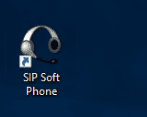
If you can’t locate the icon, go to your Windows start menu and type in “SIP”. Double-click the SIP icon at the top of your search window to launch.
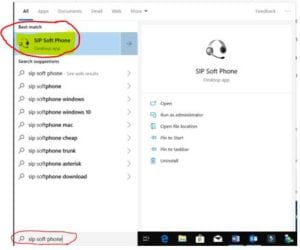
2. Right-click on the icon and select “Pin to taskbar”. This will ensure that the SIP icon appears on your taskbar moving forward, making it easy to locate:
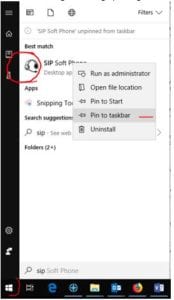
3. Right-click the icon again and wait for the menu to appear, then click “Run as administrator.” If you do not select the “Run as Administrator” option, this step will fail. This is especially important for Win11 users, so please do not skip the guidance.
Note: If you encounter the message below, asking you want to allow the app to make changes, click “Yes.”
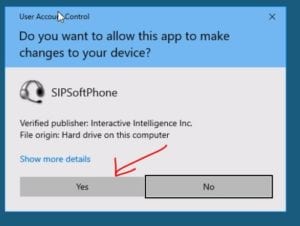
4. In the window that appears on the lower-right of your screen, click the “Provision SIP Soft Phone” link (underlined in blue):
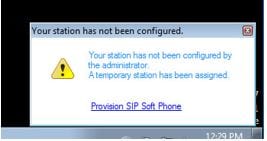
5. On the “Provisioning Wizard” page that appears, click “Next” to begin:
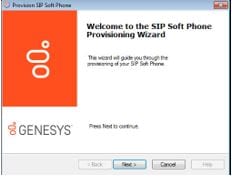
6. In the text cell, replace “eggencic1” or “fwgencic1” with “genphone” (copy-paste directly from here if needed). When you’re done, click “Next.”
You’ll see this to start:
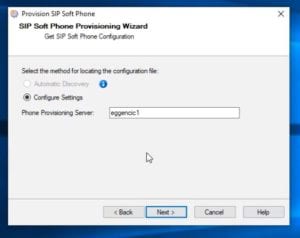
Change to “genphone”:

7. On the certificate screen enter the username you received in your tech setup email: “irdev\YourUserName” (e.g.: irdev\Jane_Smith, or irdev\jsmith, depending on your username format), and your password (e.g.: js1234).
IMPORTANT: If you don’t add “irdev\” to your user name here, you will run into SIP functionality issues. DO NOT SKIP THIS.
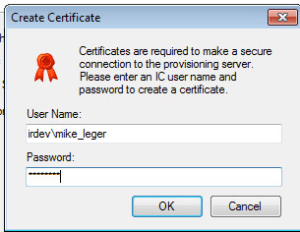
Click “OK”
8. On the adapter screen, select “I use a VPN or another kind of connection. Allow me to select my network adapter”. In the dropdown, select the “SonicWall NetExtender” option:
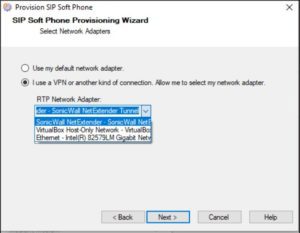
9. Proceed forward: you should come to a screen that says “Your SIP Soft Phone is provisioned and ready for use.” Click the “Finish” button.
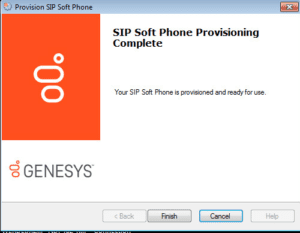
NOTE: If you encounter a screen with an image of a dialpad on it, chat IT Support using the chat feature on this web page.
Dialpad screen that you may encounter:

You are now ready to move on to Step 7: Log into your SIP Softphone
Step 7: Log into your SIP Softphone
1. On your desktop look for the icon called SIP Softphone (icon of a headset). This should be pinned to your taskbar, if you completed all of the steps in “Step 3: Provision your SIP Softphone”.
If you can’t locate the icon, go to your Windows start menu and type in “SIP”. Double-click the SIP icon at the top of your search window to launch.

2. Right-click on the icon and wait for the menu to appear. Choose Run as administrator.

3. You will receive a pop up asking if you wish to run the software:
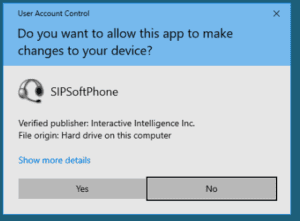
4. Click “Yes” and wait a few moments before proceeding.
5. Click the upward-pointing arrowhead (looks like a pitched roof) that is in the bottom-right corner of your task bar (to the left of where your time displays) and make sure you see a round icon with a headset:
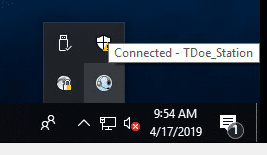
6. Check that when you hover your mouse over the icon, it shows a message saying you’re “Connected” to your station (it’ll list your station name, which is your username_station).
7. Right-click on the icon of the headset that you’ve been hovering over and choose “Options” (icon of the checklist).
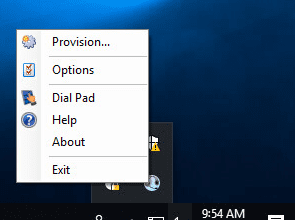
8. In the pop-up window that appears, click the “Audio Connection” tab on the left and make sure that it shows the headset you’ll be using. Adjust as needed.
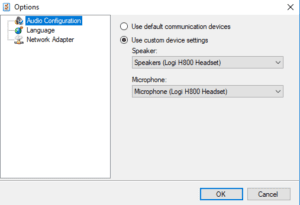
9, Click on the “Network Adapter” tab, and choose the option that has the word ‘SonicWall NetExtender’ in it: 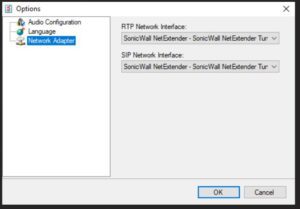
10. Click OK to close this window.
You are now ready to move on to Step 8: Test Call
Step 8: Test Call and Adjust View Settings
You’ll now test receiving a call using your SIP softphone in Interaction Connect.
Before you begin working through the steps listed below, make sure that your SonicWall VPN is connected.
Remember to use Chrome as your browser.
Test Call
1. Make sure your USB headset is plugged directly into your machine and then click this link to go to our Interaction Connect login page.
2. Bookmark the page so that you can easily find it later. Do this by clicking the little star icon on the far-right of the URL bar:

3. Click “Windows Authentication” as your login method:

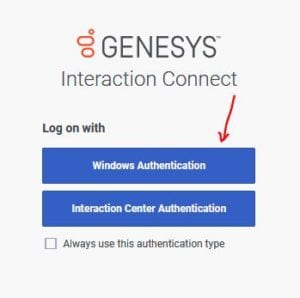
4. In the drop-down that appears from the top of your browser screen, enter the username and password that were emailed to you. Click “Sign In”.
TIP: If you have trouble with this step, try entering your username with IRDEV\ in front of your username (e.g.: IRDEV\jsmith).
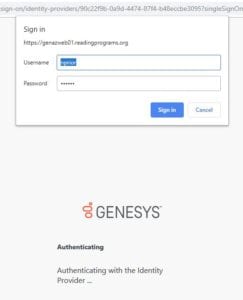
After clicking “Sign In”, Chrome may ask if you would like to enable notifications, click on “Enable”, and then click “Allow”.
5. From the “Choose a Station” menu box, click the drop-down toggle to the right of the station type field, and select “Workstation” from the list. Enter your station name (username_Station).

Make sure your USB headset is selected as your microphone and speaker options, and then click the blue “Choose Station” button on the bottom-right.
6. Change your status to “Available” on the mid-right of the task bar (you will have been automatically set to “Not Ready” upon login):

7. Click the icon of the phone to the left of the “Available” status:
![]()
Type 8009032755 into the “Dial a Number” field (no dashes, or spaces):
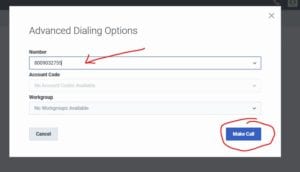
Click the blue “Make Call” button on the bottom right of the menu.
8. Once you reach the voicemail box, leave a message with your full name and phone number, and tell us what city and state you’re calling from. A member of our team will listen to confirm your test call and check your call quality: if the tech hears an issue, he or she will reach out to you to test again.
Step 9: Click the red “Disconnect” icon to end the call from Interaction Connect:

Adjust View Settings
1. Click the blue “Add Views” text in the middle of the screen:

2. Select “My Interactions”, “Call History”, “Current Interaction”, and “My Schedule” options, and then click the blue “Add 4 Views” button on the bottom-right of the pop-up:

Your view should now look like this:

3. Log out of Interaction Connect: click the downward arrow on the upper-right of the screen, and then click the blue “Log Off” button..
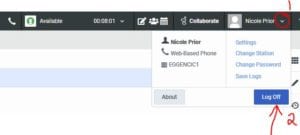
Problem-Solving Guidance
If you are not able to successfully complete a test call on your first try, please check your credentials against the email you received with your login information and go through the steps one more time. If you are still not successful, please use the chat feature pop-out on the right of this page to contact IT Help Desk.
Even if you did not complete your test call, please move on to Step 9: Submit Webform.
Step 9: Submit Webform
Please complete the webform below to let us know that you’ve completed tech setup, or that you’ve encountered trouble. If you need assistance and didn’t reach anyone via chat, a support tech will reach out to you as soon as possible after reading your entry.
NOTE: Everyone must complete the form. The form is used to verify that you’re ready for training.
Copyright © 2024 Institute of Reading Development